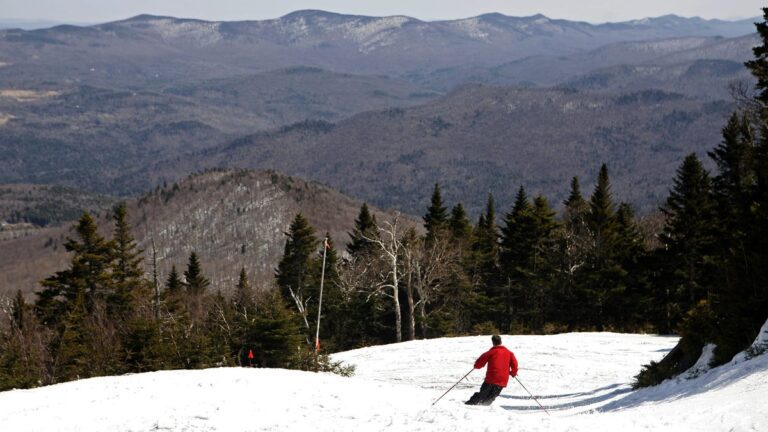The storms, floods, heatand fires that have ravaged the US in 2021 have made the ongoing climate crisis feel especially acute for citizens across the country. And the latest Report of the Intergovernmental Panel on Climate Change indicates the escalating risks the world faces as the climate warms. In such a bleak future scenario, where will it be as safe and livable as today?
Researchers looked at many factors from sea level rise to heat to rate the least dangerous place to live in the US as the climate warms. Nowhere will climate change escape unscathed. However, one region emerged far ahead of the rest: the US Northeast.
Of the 10 lowest-risk counties, six were in Vermont, and most of the rest were in northeastern states like Maine and New York, according to study by ProPublica and the New York Times Magazine. The data on relative risk for US counties threatened by climate change was compiled from data collected by the Rhodium Group, an independent data analysis firm, as well as various academic studies.
- Lamoille County, Vermont
- Orange County, Vermont
- Franklin County, Vermont
- Essex County, Vermont
- Piscataquis County, Maine
- Orleans County, Vermont
- Grand Isle County, Vermont
- Hamilton County, New York
- Franklin County, Maine
- Aroostook County, Maine
The study represented how six factors—heat, wet bulb temperatures, sea-level rise, crop yields, wildfires, and economic damage—combined to affect people and economies. These safer areas were expected to have the lowest combined impacts by mid-century. Temperatures, fires and rising sea levels will cause much of the damage. Rising temperatures mean that intense heat and humidity will shift the zone of mild climate and arable land northward. Places like Arizona and Texas are expected to sizzle under combined heat and humidity, known as “wet bulb” temperatures, which make it nearly impossible for the human body to cool down for part of the year. Coastal sea level rise and wildfires in the western US mean inland states in the Northeast are becoming prime locations.
Vermont's natural advantages
Overall, Vermont counties were projected to experience relatively little damage to local economies as a result of climate change. Because of its geographic location, Vermont's long cold winters and mild summers mean it faces some of the lowest risks of dangerous temperatures and humidity. In fact, cooler, wealthier economies like those in Vermont are benefiting from warming, according to Hannah Hess, who led the Rhodium Group research from which this report is drawn.
Annual temperatures in the state currently range between 33ºF (0.5º C) and 55ºF (13º C). As the climate warms, fewer cold days in winter can improve health and infrastructure and reduce energy costs, creating a net positive effect on the economy, Hess says. The geography of Vermont also means the state, which is 75% forest (pdf), is at low risk of fire and crop yield reduction. While rural returns are likely to decline steeply in the southern US, Vermont experiences warmer summers and longer growing seasons benefiting certain crops (although some like maple syrup decreasing as temperatures rise).
Local leaders are taking action now to adapt to the future
State and local leaders in Vermont are also taking action now to ensure the state can withstand the myriad challenges of climate change. The most immediate threat is extreme weather events. His remains Tropical Storm Irene (downgraded by a hurricane) in 2011 caused massive flooding, six deathsand $700 million compensation on roads, bridges and infrastructure.
In response, the state government has taken action to make the built environment more resilient by adapting it to changing climate conditions. The government created new construction standards for floodplains and restored natural wetlands to act as a natural barrier to overflowing rivers.
🎧 For more on climate change, listen to the Quartz Obsession podcast episode on kudzu. Or sign up via: Apple Podcasts | Spotify | Google | Stitcher.
“Coming out of the storm really changed our perspective on the importance of resilient infrastructure,” said Julie Moore, the undersecretary for natural resources. “The aim is to avoid future conflicts [between people and the river].”
Work is being done in agriculture to prepare farmers for “a full range of conditions,” says Moore. This has research to help farmers improve soil health and its ability to hold water, as well as a initiative to study the potential effects of carbon sequestration in soil. Local groups are also working to bolster the state's maple confectionery industry against climate change by encouraging producers to protect forest diversity.
Like many other states and localities, Vermont has developed a climate action plan, which includes efforts to reduce carbon emissions and shift energy sources away from fossil fuels. The plan also includes those adaptive measures, such as wetland restoration and educating residents about tick-borne diseases to prepare residents for climate changes that are already here.
“There's always going to be a bigger flood, there's always going to be a more intense storm, so none of these solutions are perfect,” Moore says. “But we're trying to take advantage of opportunities to limit future damage.”
Correction (Sept. 14): An earlier version incorrectly stated that seven of the 10 safest counties were in Vermont and listed them incorrectly. Six of the 10 are in Vermont, with the remaining counties in Maine and New York.



